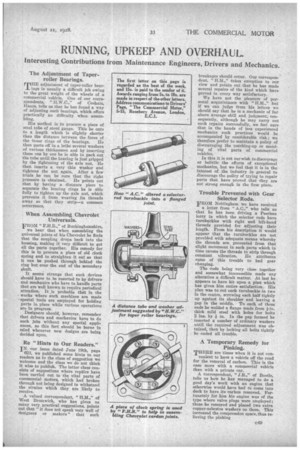RUNNING, UPKEEP AND OVERHAUL.
Page 33

If you've noticed an error in this article please click here to report it so we can fix it.
Interesting Contributions from Maintenance Engineers, Drivers and Mechanics.
The Adjustment of Taperroller Bearings.
MHE adjustment of taper-roller bear
ings is usually a difficult job owing to the great weight of the wheels of a commercial vehicle. One of our correspondents, "II.W.C.," of Cosham, Hants, tells us that he has found a way of adjusting such bearings, which offers practically no difficulty when assembling.
His method is to procure a piece of steel tube of stout gauge. This he cuts to a length which is slightly shorter than the distance between the faces of the inner rings of the bearings. He then parts off in a lathe several washers of various thicknesses and by inserting these one by one he is able to pack out the tube until the bearing is just gripped by the tightening of the axle nut. He then inserts a very thin washer and tightens the nut again. After a few trials he can be sure that the right pressure is obtained. He points out that by having a distance piece to separate the bearing rings he is able fully to tighten up the axle nut, which prevents it from wearing its threads away so that they strip—a common occurrence.
When Assembling Chevrolet Universals.
Fizom "F.H.R.," of Buckinghamshire,
we hear that when assembling the universal joints of his Chevrolet he finds that the coupling drops back into the housing, making it very difficult to get all the parts together. His remedy for this is to procure a piece of old clock spring and to straighten it out so that it can be pushed through behind the ring but over the end of the secondary shaft.
It seems strange that such devices should have to be resorted to by drivers and mechanics who have to handle parts that are well known to require periodical attention. It is probable that in the works where such machines are made special tools are employed for holding parts in place while various operations are in progress.
Designers should, however, remember that drivers and mechanics have to do such jobs without any special appliances, so this fact should be borne in mind whenever new designs are being decided upon.
Re "Hints to Our Readers."
IN our issue dated June 19th, page 823, we published some hints to our readers as to the class of suggestion we welcome and the class we do not think it wise to publish. The latter class consists of suggestions where repairs have _ been carried out to the vital parts of commercial motors, which had broken through not being designed to withstand the strains which they are likely to receive.
A valued correspondent, " H.M.," of West Bromwich, who has given us many very practical suggestions, points out that "it does not speak very well of designers or makers" that such breakages should occur. Our correspondent. " H.M.," takes exception to our view and points out that he has made several repairs of the kind which have proved in every way satisfactory.
We have not the pleasure of personal acquaintance with "H.M.," but if we can judge from his letters we should say that he is a mechanic of far above average skill and judgment, consequently, although he may carry out such repairs successfully, we feel sure that in the hands of less experienced mechanics such practices would be accompanied by considerable risk ; we therefore prefer to maintain a policy of discouraging the patching-up or mending of vital parts of commercial vehicles.
In this it is not our wish to discourage or belittle the efforts of exceptional mechanics, but we feel that it is in the interest of the industry in general to discourage the policy of trying to repair parts that have proved that they are not strong enough in the first place.
Trouble Prevented with Gear Selector Rods.
FROM Nottingham we have received
a letter from " A.C.," who tells us that he has been driving a Peerless lorry in which the selector rods have turnbuckles with right and left-hand threads provided for adjusting their length. From his description it would appear that the turnbuckles are not provided with adequate means whereby the threads are, prevented from that slight movement in such parts which in time causes the threads to strip through constant vibration. He attributes some a this trouble to bad gear changing.
The 'rods being very close together and somewhat inaccessible made any alteration a difficult matter. At last he appears to have hit upon a plan which has given him entire satisfaction. His plan was to cut each turnbuckle in two in the centre, screwing each half tightly up against its shoulder and leaving a gap in the middle. To each of these ends he welded a flange made from I-in. thick mild steel with holes for bolts 2 ins, by in. In the gap formed he inserted a number of ordinary washers until the required adjustment was obtained, then by locking all bolts tightly he ended all trouble.
A Temporary Remedy for Pinking.
THERE are times when it is not con venient to have a vehicle off the road for the removal of carbon. This is the case more with a commercial vehicle than with a private car.
A correspondent, " J.R.," of Bootle, tells us how he has managed to do a good day's work with an engine that otherwise would have had to come into dock to have its carbon removed. Fortunately for him his engine was of the type where valve plugs were employed ; these he remoyed and placed two extra copper-asbestos washers on them. This increased the compression space, thus relieving the pinking


































